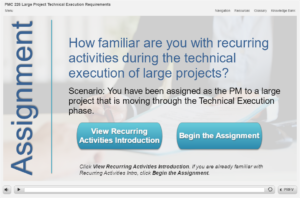
Let’s face it, not everyone is super stoked about taking your latest eLearning course. Whether they’re busy, lazy, feel they already know the information, or are unabashedly anti-learning, sometimes streamlining the path through a course is the best option. In our last article, we talked about failure driving your course content. In this article, we’ll look at how putting those pre-tests up front can also save learners time and the company money.
Determine Your Primary Goal: Knowledge Transfer or Practical Application
The most important consideration with this approach is whether your learners are familiar enough with the content. If your main priority is to teach new content that learners wouldn’t reasonably be able to figure out, don’t use this approach. However, if your main goal is to take things they’re already familiar with, and test their ability to use that knowledge in new ways, this can be great. This strategy works best in “common sense” type training (like many compliance courses) or the complex application of knowledge learners already have. In either of these cases, they have a knowledge foundation to rely on. If you use this approach with the wrong content, your learners will be lost and possibly kinda angry at you.

As we discussed last time, this course was structured around the premise of test first, present content as needed. To accomplish this, each section gave the learner a choice to view the content or proceed directly to the assignment.

Provide Sufficient Support
Like throwing someone into the deep end of the pool, it’s best to also provide them with some support. Ideally, the tests in an application-style course should be challenging. In our project, we had learners applying complex concepts that they were familiar with, to new and challenging situations. So, to help them be successful, we provided them with a variety of support mechanisms.

Each assignment had a “Coach Tip” which was a like a hint. When applicable, we also included a Job Aid relevant to the situation. Finally, if any assignment was too challenging, we gave them the option to view the content before continuing with the test. This scaffolded approach provided challenge to learners, without forcing them down a frustrating path.
Pre-Tests Can Empower Learners
One of the cornerstones of Adult Education principles is giving learners choices. Adult learners, especially in today’s On-Demand society, don’t have the patience to sit through things they think they already know. Giving them the ability to control their own path is empowering and crucial to maximizing the learning process. When someone feels locked into a path they don’t control, you’re just building up their frustration. Needless to say, if someone is focused on how annoyed they are, they probably aren’t absorbing much of your course.
Another crucial aspect of Adult Learning is providing a safe environment to make mistakes. This is key to real engagement in your courses. In fact, Embrace Failure is even one of ThinkingKap’s principles and rules for success. If learners can just skate through your course, they wonder why they’re wasting their time. But if it provides meaningful and reasonable challenges, that’s when we create real connections.
Lower Seat Times Make Everyone Happier
Trust me, no matter how kick-ass you think your latest eLearning course is, a little goes a long way. Most learners, even if they enjoy your courses, have other things they’d like to (or need to) be doing. And guess what, management ALWAYS has better things for employees to do than sitting in training classes. So, whenever you can reduce seat time, you’re going to make a lot of people a little happier.
In reality, the full course isn’t any shorter. If someone chooses to view the content before each assignment, the course would take the “normal” amount of time. However, for anyone familiar with the content, they have an opportunity to get done much quicker. Advanced learners could skip all of the instruction and just do the assignments. If they can prove they know what they’re doing, they’ll finish the course MUCH quicker.
This provides an incentive, both for the learners and for management. Learners will obviously be happy to finish quicker. Management gets the assurance that everyone who completed the course demonstrated proficiency. They also know that their higher performing employees spent less time in the course. This means more time back on the job (allegedly) doing more productive things.
Win-Win.
